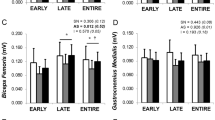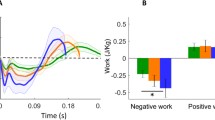Summary
The relationships between ground reaction forces, electromyographic activity (EMG), elasticity and running velocity were investigated at five speeds from submaximal to supramaximal levels in 11 male and 8 female sprinters. Supramaximal running was performed by a towing system. Reaction forces were measured on a force platform. EMGs were recorded telemetrically with surface electrodes from the vastus lateralis and gastrocnemius muscles, and elasticity of the contact leg was evaluated with spring constant values measured by film analysis. Data showed increases in most of the parameters studied with increasing running speed. At supramaximal velocity (10.36±0.31 m×s−1; 108.4±3.8%) the relative increase in running velocity correlated significantly (P<0.01) with the relative increase in stride rate of all subjects. In male subjects the relative change in stride rate correlated with the relative change of IEMG in the eccentric phase (P<0.05) between maximal and supramaximal runs. Running with the towing system caused a decrease in elasticity during the impact phase but this was significant (P<0.05) only in the female sprinters. The average net resultant force in the eccentric and concentric phases correlated significantly (P<0.05−0.001) with running velocity and stride length in the maximal run. It is concluded that (1) increased neural activation in supramaximal effort positively affects stride rate and that (2) average net resultant force as a specific force indicator is primarily related to stride length and that (3) the values in this indicator may explain the difference in running velocity between men and women.
Similar content being viewed by others
References
Cavagna GA, Komarek L, Mazzoleni S (1971) The mechanics of sprint running. J Physiol 217:709–721
Cavagna GA, Kaneko M (1977) Mechanical work and efficiency in level walking and running. J Physiol 263:467–481
Cavanagh PR, Lafortune MA (1980) Ground reaction forces in distance running. J Biomechanics 13:397–406
Dempster WT (1955) Space requirements of the seated operator. WADC Technical Report 55-159. Wright-Patterson Air Force Base, Ohio
Dietz V, Schmidtbleicher D, Noth J (1979) Neuronal mechanisms of human locomotion. J Neurophysiol 42:1212–1222
Durnin J, Rahaman M (1967) The assessment of the amount of fat in the human body from the measurement of skinfold thickness. Br J Nutr 21:681–689
Fukunaga T, Matsuo A, Yuasa K, Fujimatsu H, Asahina K (1978) Mechanical power output in running. In: Asmussen E, JØrgensen K (eds) Biomechanics VI-B. University Park Press, Baltimore, pp 17–23
Gollhofer A, Schmidtbleicher D, Dietz V (1984) Regulation of muscle stiffness in human locomotion. Int J Sports Med 5:19–22
Ito A, Komi PV, Sjödin B, Bosco C, Karlsson J (1983) Mechanical efficiency of positive work in running at different speeds. Med Sci Sports Exerc 15:299–308
Kaneko M, Ito A, Fuchimoto T, Shishikura Y, Toyooka J (1985) Influence of running speed on the mechanical efficiency of sprinters and distance runners. In: Winter DA, Norman RW, Wells RP, Hayes KC, Patla AE (eds) Biomechanics IX-B. Human Kinetics Publishers, Champaign, Ill, pp 307–312
Komi PV (1983) Biomechanical features of running with special emphasis on load characteristics and mechanical efficiency. In: Nigg B, Kerr B (eds) Biomechanical aspects of sport shoes and playing surfaces. University of Calgary, pp 123−134
Komi PV (1985) Ground reaction forces in cross-country skiing. In: Winter DA, Norman RW, Wells RP, Hayes KC, Patla AE (eds) Biomechanics IX-B. Human Kinetics Publishers, Champaign, Ill, pp 185–190
Komi PV, Kaneko M (1983) Mechanical efficiency of negative and positive work. Med Sci Sports Exerc 15:171
Kuo S (1965) Numerial methods and computers. Addison Wesley Reading, Massachusetts, pp 234–235
Luhtanen P, Komi PV (1978) Mechanical factors influencing running speed. In: Asmussen E, JØrgensen K (eds) Biomechanics VI-B. University Park Press, Baltimore, pp 23–29
Luhtanen P, Komi PV (1980) Force-, power-, and elasticity-velocity relationships in walking, running, and jumping. Eur J Appl Physiol 44:279–289
Mann RA, Hagy J (1980) Biomechanics of walking, running, and sprinting. Am J Sports Med 8:345–350
Mero A, Komi PV (1985) Effects of supramaximal velocity on biomechanical variables in sprinting. Int J Sport Biomechanics 1:240–252
Miller DI (1978) Biomechanics of running — what should the future hold? Can J Appl Sport Sci 3:229–236
Miyashita M, Matsui H, Miura M (1971) The relation between electrical activity in muscle and speed of walking and running. In: Vredenbregt J, Wartenweiler JW (eds) Biomechanics II. University Park Press, Baltimore, pp 192–196
Payne AH (1978) A comparison of the ground forces in race walking with those in normal walking and running. In: Asmussen E, JØrgensen K (eds) Biomechanics IV-A. University Park Press, Baltimore, pp 293–302
Schmidtbleicher D, Dietz V, Noth J, Antoni M (1978) Auftreten und funktionelle Bedeutung des Muskeldehnungsreflexes bei Lauf- und Sprintbewegungen. Leistungssport 8:480–490
Author information
Authors and Affiliations
Rights and permissions
About this article
Cite this article
Mero, A., Komi, P.V. Force-, EMG-, and elasticity-velocity relationships at submaximal, maximal and supramaximal running speeds in sprinters. Europ. J. Appl. Physiol. 55, 553–561 (1986). https://doi.org/10.1007/BF00421652
Accepted:
Issue Date:
DOI: https://doi.org/10.1007/BF00421652




